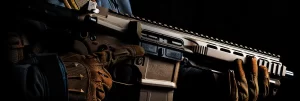The National Firearms Act was enacted by Congress on June 26, 1934. It was largely seen as a response to the rise of organized crime during the Prohibition era, in which many high-profile incidents featured machine guns. One such incident was the 1929 St. Valentine’s Day Massacre, when Al Capone’s Chicago Outfit murdered seven members of the North Side Gang.
The Thompson submachine gun that was used in the massacre was the weapon of choice for organized crime during this era. The purpose of the National Firearms Act was to tax the manufacture and transfer of certain types of weapons and accessories with the intention of reducing or eradicating their existence. The original tax amount of $200 remains unchanged today, meaning the equivalent fee was over $4,000 at the time of the law’s inception.
There are six main categories that are included under the National Firearms Act
- machine guns
- short-barreled rifles
- short-barreled shotguns
- suppressors
- destructive devices
- and those that are designated as “any other weapon”.
Machine Guns
A machine gun is defined as any firearm that can fire repeatedly with only one pull on the trigger. The Firearm Owners Protection Act of 1986 banned the sale of machine guns manufactured and registered after the date of its enactment to civilians. Currently, machine guns created after that date can only be owned or possessed by the military or law enforcement.
SBR or short barreled rifle
A short-barreled rifle is defined as having a barrel less than 16 inches long as measured from the tip of the barrel to the closed bolt or an overall length of less than 26 inches. This is commonly determined by inserting a dowel rod into the barrel until it is stopped by the bolt, then marked, removed, and measured. A short-barreled shotgun that is subject to the NFA has a barrel length of less than 18 inches or an overall length of less than 26 inches.
Suppressors
Although not, by themselves, weapons, suppressors are included in the National Firearms Act as well. Also called silencers, suppressors are considered to be any devices that muffle the sound of a portable firearm report. They can be made from an assemblage of parts or purchased ready-made. The parts that are specific to the purpose of being made into a suppressor are also regulated.
Destructive devices
The destructive devices category includes any object that contains explosives or poisonous gases. Bombs, grenades, large rockets, and poisonous gas explosives are included, as well as large-bore firearms.
Any other weapon
The “any other weapon” category refers to weapons that are disguised or can be concealed. Items that appear to be pens, umbrellas, cigarette lighters, etc. are in this group as well as hybrid weapons that combine shotgun and rifle parts and are between 12 and 18 inches in length. Probably the best known AOW item is the vertical foregrip.
When this modification is added to a pistol or revolver as a second vertical foregrip, it changes the design of the weapon, necessitating two hands to fire it. This renders the item inconsistent with its original use, which designates it as an AOW under the National Firearms Act.
There have been surprisingly few iterations of the National Firearms Act since 1934. The Gun Control Act of 1968 expanded its scope to include destructive devices and various parts used in the construction of machine guns and changed the some of the rules regarding registration. The Firearm Owner’s Protection Act prohibited civilian machine gun possession for those weapons manufactured and registered before 1986.
Various opinion letters have added and removed details of the requirements for specific weapons over the years as technology has changed, but the main tenets of the NFA have remained the same. Through this system, all regulated items are applied for, registered, and taxed, and the details of the weapons and their owners are stored in a national database.
It has been a remarkably effective system for reducing the use of these kinds of weapons in crimes, as they are difficult to obtain and their mere possession is a felony. Although in recent years, gun control advocates have pushed for the inclusion of all firearms into a similar system, it remains one of the most polarizing and stagnant issues in American politics today.


 What is an Assignment of Property and Why Do I Need One for my Trust?
What is an Assignment of Property and Why Do I Need One for my Trust?